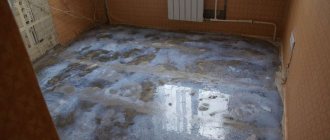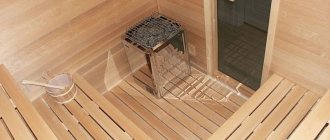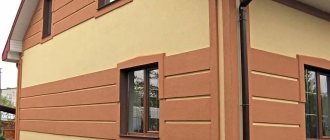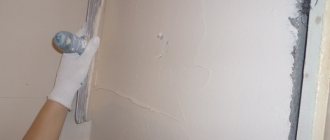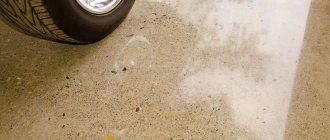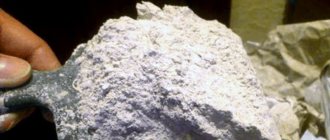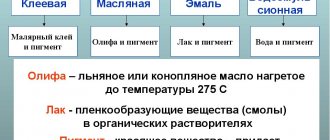Putty for concrete floors is a special building material that is supplied in the form of a dry or liquid mixture that requires preparation, intended for finishing surfaces in order to implement various tasks. Most often, concrete floors are covered with putties to give them the necessary characteristics of rigidity and strength, extend their service life, level them, and prepare them for finishing.
A concrete floor experiences high mechanical loads and must be as reliable, wear-resistant, and able to withstand aggressive influences. Due to the peculiarities of the porous structure of a concrete monolith, untreated concrete can become dusty and deteriorate over time, subject to the spread of a network of cracks and the appearance of other deformations (chips, potholes, etc.).
Even if you plan to finish the concrete with a floor covering, pre-treatment of the surface will extend the service life of the finishing layer and eliminate a lot of problems. One way or another, concrete reinforced with putty demonstrates increased characteristics of durability, comfort, and strength. In addition, putties are used to level concrete in the presence of small differences.
What is putty used for?
The concrete floor itself has high strength, but if there are minor defects (chips, cracks and crevices) and poorly puttied slab joints, it can be subject to destruction, which will entail repairs and significant financial costs, especially when it comes to public buildings.
Cracks in concrete
Additional strengthening of the concrete base will also be required in cases where cheap materials were used in construction. Treated floors have a number of advantages:
- high wear resistance;
- resistance to erosion;
- resistance to abrasion and mechanical damage, exposure to chemicals and moisture (including leaks);
- longer operating period.
Putty mixtures thoroughly and reliably level the floor, ensuring easier further installation of building and decorative materials.
Putty mixtures
Properties
Putty is selected in accordance with the functions it must perform. So, for example, for floors in industrial premises it may be important to ensure maximum wear resistance and strength, for certain residential premises - to minimize exposure to moisture and temperature changes.
But most compositions demonstrate approximately the same properties, increasing the basic technical characteristics of concrete, since we are talking about a surface that is constantly under load.
What kind of putty should be used for a concrete floor:
- Resistance to mechanical damage is more important the higher the expected loads.
- Ensuring good adhesion with other materials.
- Resistance to water and moisture.
- Long service life.
- Wear resistance.
- Safety and environmental friendliness for people.
Putties are selected according to the type of finishing coating, the purpose of the room, the functions of the floor and other factors. The modern market offers a fairly large selection of various compositions, most of which meet basic requirements, while for specific ones it is important to select specific substances.
Putty mixtures for concrete
Putty materials can be basic and finishing. But there are also intermediate universal options suitable for all operations; they are much more economical and have low consumption.
Putty for concrete floors
Based on their component composition, mixtures of the following types are distinguished:
- cement;
- gypsum;
- limestone;
- oil;
- adhesive;
- varnish;
- polymer or acrylic.
Basic putty PROMOTERS 5 kg
Often, manufacturers additionally enrich the putty with polyester or polyurethane additives. Such materials have minimal shrinkage and high waterproofing properties.
| Name of putty | Average consumption per 1 m2, kg |
| Facade putty | 1,15 — 1,5 |
| Oil-adhesive | 2,75 |
| Adhesive | 0,50 |
| Plaster | 0,80 |
| Finish | 0,45 |
According to the form of release, the mixtures are:
- dry, diluted with water in the specified proportions;
- paste - ready-to-use compositions.
Alpina Feinspachtel finishing putty for treating walls and ceilings made of gypsum boards and concrete
Depending on the application method, the putty can have a liquid or thick consistency. The first type is typical for self-leveling compounds used for treating concrete floors. Such mixtures, under their own weight, are effortlessly distributed evenly over the entire surface, characterizing the continuous puttying technique.
Technology for leveling the floor with putty during do-it-yourself repairs
Before starting puttying, the concrete surface is thoroughly cleaned of debris and dust - for this you can use a construction vacuum cleaner or an ordinary broom. Next, priming is carried out to ensure better adhesion of the materials.
The putty is simply poured onto the floor, and then carefully leveled with a spatula or a special brush over the surface. This makes it possible to obtain a thin coating that is as evenly and evenly distributed as possible over the floor. After the work is completed, the room should be wet cleaned and everything should be thoroughly cleaned.
The modern market offers a fairly large selection of various putties for concrete floors that meet various requirements, guarantee the required characteristics and must be used strictly according to the instructions.
Gypsum mixtures
Eco Finish gypsum finishing putty
Gypsum-based putty mixtures are the least popular option for leveling the surface of concrete floors. The advantages of this material include:
- no shrinkage;
- low cost.
The gypsum composition creates a perfectly smooth surface from the first layer, dries quickly and can be colored with any color (as a more budget-friendly option, you can use artistic gouache), however, it has one significant drawback - the material is not suitable for rooms with high humidity.
Price for gypsum putty
gypsum putty
Self-cooking
If desired, it is easy to prepare the putty mixture with your own hands. The main ingredient is 10% animal glue. You will need 100 g of it. In addition, you will need 500 ml of drying oil, 125 g of turpentine (can be replaced with kerosene), and 25 ml of liquid drier. An additional ingredient is liquid soap. Chalk will add thickness. It must first be dried and sifted.
First of all, heat up the glue. Soap is gradually added to it. The solution is not removed from the heat and stirred constantly. Then drying oil, drying agent and turpentine are introduced into it. Chalk is added last. The consistency should be like thick sour cream. The floor is treated with a warm mass. To maintain the temperature, it is placed in a steam “bath” or placed in a container with hot water.
An easier way to putty with your own hands involves using PVA glue with chalk or dry finishing putty. Glue is poured into the container, water is added to it (for 1 part of glue, take 2 parts of water). Gradually add the dry mixture, stirring until a homogeneous thick mass is obtained. If there are a lot of uneven surfaces on the wooden floor, you can add small sawdust. This mixture dries in about a day.
Cement putties
Prospectors basic cement putty (20 kg)
Cement-based putty mixtures successfully combine reasonable prices, consistently high quality coatings and moisture-resistant properties. But the material also has a number of disadvantages, including:
- noticeable shrinkage after complete drying;
- the difficulty of leveling the mixture on the surface and the need for certain skills in working with cement compositions.
Special component mixtures make the finished coating resistant to temperature changes and allow the use of such putties in rooms with extremely low and high humidity, since strength and durability are maintained throughout the entire service life.
Price for cement putty
cement putty
conclusions
In conclusion, we can conclude that the putty mixture for concrete is the most versatile material, thanks to which, without much effort, you can quickly eliminate any defects that appear in the form of cracks, irregularities, and bumps.
But it is necessary to choose the right putty, based on the characteristics of the surface being treated. In Sevastopol, you can find the necessary type of putty in any department of stores intended for construction work. We also recommend that you read the article about tile adhesive Ceresit cm 11.
Acrylic mixtures
Acrylic putty
One of the most convenient forms - it hardens quickly and creates a smooth surface. The multi-component system is not subject to shrinkage and is not afraid of water.
In addition to water, the composition of polymer putty for concrete floors includes sand, marble chips, cement, and synthetic additives. This putty is plastic, has good waterproofing properties and adhesion to the surface being treated, is waterproof, and elastic, which makes it an excellent material for preparing surfaces for self-leveling and heated floors. But its use is advisable on surfaces with a small number of deep cracks and gouges.
Price for polymer putty
acrylic putty
What to choose for finishing wooden flooring?
Both base and finishing putty for leveling the floor can be intended exclusively for wooden flooring. However, other canvases can be puttied with similar materials. It all depends on the composition and individual characteristics of the floor.
In order to improve a wooden floor, the following types of putty are best suited:
- Acrylic putty;
- Based on various solvents;
- Oil analogues;
- Polymer putty (also used for lamination).
Cement and known putty are not used for treating wooden surfaces. It is also extremely rare to use adhesives.
Epoxy mixtures for concrete floors
Epoxy putty 250 g
If it is necessary to level and strengthen a concrete base with a damaged structure (large cracks, embroidered seams and traces of reinforcement removal), the most effective would be the use of epoxy putty mixtures, which tighten the concrete and increase its strength and durability.
Price for epoxy putty
Epoxy putty
The advantages of such two-component systems, consisting of a base and a hardener, are:
- high-quality filling of cracks, crevices, joints;
- elimination of voids formed in places where pipes, communications, etc. were replaced;
- strengthening difficult areas and tightening structural damage;
- the ability to create a durable and wear-resistant continuous coating that does not require further processing;
- high adhesive properties;
- minimum percentage of detachment of the dried putty layer from the base;
- resistance to moisture, chemicals, as well as microbes, mold and mildew.
Epoxy mixture is a finishing material ideal for smoothing out all the depressions and unevenness of the floor covering.
Epoxy resin putty
Types and properties of wood putties
In everyday life and in production, a variety of wood putties are used, which differ in the components they contain. The principle of operation of different materials is approximately the same - they prevent the penetration of moisture into microcracks, recesses and holes, eliminate visible defects and prevent the base from becoming dirty. Most often, putties are used when processing frames, doorways and panels, floor coverings, baseboards, plywood, etc.
Plaster
Such putties are not suitable for outdoor work because they tend to strongly absorb moisture. In addition, in terms of strength and elasticity, they are inferior to many analogues. It is better to use such materials only for small areas that will not be exposed to aggressive environmental factors. They can also be used to seal internal wooden bases in dry rooms. The advantages of gypsum putties include high vapor permeability, environmental friendliness, preservation of the natural microclimate in the house and low price.
Acrylic
Acrylic putty is quite often used for woodwork. This material is non-toxic, does not emit any odor, and can be used for exterior and interior use. Waterproof acrylic putty is not afraid of moisture, temperature changes, and moderate mechanical loads. It adheres securely to the base and is suitable for treating floors and exterior walls of a building. The composition can be used to seal small cracks and wood pores, as well as deep defects in wood. After drying, high-quality acrylic putties are characterized by low shrinkage and can be washed. Other advantages of acrylic-based materials are:
- high aesthetic qualities;
- ease of application due to plasticity;
- elasticity and absence of cracking in the future;
- long service life;
- protection of boards from fire;
- Possibility of sanding after drying.
Non-shrinking composition for wood based on acrylic
Latex
Putties with a latex base are characterized by very high plasticity, easy to apply and level with a spatula. They are characterized by excellent adhesion to wood, are firmly fixed on its surface and withstand further mechanical processing - planing, sawing, sanding, etc.
This group of materials can be used for interior and exterior work, since it is frost-resistant and does not deteriorate due to temperature changes. Latex putties are suitable for places with high humidity, and after drying they can be painted in any shade. They can be used to treat walls, structures, and also be used to eliminate defects on furniture, doors, chipboard and fiberboard panels.
Polymer
Highly plastic polymer compounds allow you to repair even the deepest cracks in wood. They are characterized by:
- environmental safety;
- absence of shrinkage, peeling, cracking;
- maintaining quality under the influence of ultraviolet radiation;
- high speed of hardening and complete drying;
- long service life;
- protection of wooden surfaces from clogging and pollution;
- repelling dust.
Each polymer putty is thermal and moisture resistant. This means that the composition is ideal for outdoor use, since it does not deteriorate from moisture, frost, or high temperatures.
On an oil-adhesive basis
Such compositions are made on the basis of oils, drying oils, adhesive components, plasticizers and solvents. They are suitable for treating facades before painting them. Oil-adhesive putty is a moisture-resistant mixture that does not deteriorate from the influence of precipitation, wind, frost and other adverse factors. It allows you to create a perfectly flat plane, suitable for processing large surfaces. This type of putty is perfectly combined with other finishing materials.
Universal oil-adhesive mixture with antiseptic
Epoxy thermal and moisture resistant
Epoxy putties are two-component compositions, one part of which contains epoxy resin and pigments, and the other part contains a hardener with plasticizers. After mixing and applying the product, the most durable, durable and damage-resistant wood coating is formed. It is not afraid of deformation, does not crack, and is not subject to shrinkage. Epoxy does not deteriorate at all from water, literally repels precipitation, and can withstand repeated freezing and thawing. The finished coating can be painted and sanded. The only disadvantage of epoxy putty is the high price.
Waterproofing putty mixture
A special feature of the mixture with increased moisture-resistant properties is the possibility of using it as an independent coating, which will be beneficial with a limited budget for repair work. The composition of the putty includes urethane components, a dry base mixture, a hardener, targeted additives and dispersion emulsions.
Penetrating waterproofing compound Ceresit CR 90 Crystaliser (25 kg bag), bag
Most often, waterproofing putty is used when carrying out renovation work in bathrooms, steam rooms and showers.
The main advantage of the material is that there is no need to wait for the base to completely dry and the ability to work on a wet layer.
Price for waterproofing putty
waterproofing putty
Features and composition
The main binder is polyvinyl acetate, also known as PVA glue (GOST No. 520-20 of 2003). It is this substance that provides high adhesion. Chalk is used as a filler. Talc can be added to it, as it provides a fine fraction to create a smooth surface without potholes or bubbles.
To make PVA-based putty easier to sand, plasticizers are added to its composition. For example, carboxymethylcellulose (CMC) provides softness and, once dry, requires less effort to sand. But latex-based plasticizers prevent cracking.
Also, to improve the quality, the product contains an antiseptic that protects against mold and various additives; additives against insects and rodents can be used. Different percentages of certain additives in the composition affect the quality of the putty itself and its performance characteristics.
Ready-made mixtures are produced in plastic jars weighing from 0.5 to 3 kg. Dry putty is produced in bags weighing up to 15 kg.
Criteria for choosing putty
How to choose putty
It is very important to choose the right building mixture, taking into account the properties of the surface being treated and the purpose of the room. It is important to pay attention to the following properties of the putty mixture:
- adhesion indicator - there are special solutions for smooth surfaces;
- type of base (concrete, aerated concrete);
- moisture resistance, since the putty layer must reliably protect the concrete base from moisture;
- vapor permeability (the ability of a material to remove excess moisture).
| Type of putty | Purpose | pros | Minuses |
| Cement | For rooms with high humidity and outdoor use | Moisture-resistant, cost-effective | Significant shrinkage, possibility of cracks appearing over time |
| Plaster | For rooms with low humidity | Forms a smooth surface, does not shrink, hardens in 2-3 hours, maximum layer 4 mm | Not moisture resistant, the solution thickens in 1.5-2 hours |
| Polymer | For residential premises and rooms with normal humidity | Lightweight and easy to use, hardens quickly. The coating is smooth and glossy. Ideal for finishing coats | Expensive |
Important! Pastes and mixtures for concrete bases are not suitable for aerated concrete and vice versa. Because they contain various component additives suitable for a specific structure. When choosing a mixture, you need to remember that how evenly and smoothly the finishing materials (parquet, laminate, linoleum or ceramic tile) will lie will depend on its quality.
Step 1. Preparing the work surface
The room in which the work will be carried out must be prepared in advance. It is advisable to remove the old floor covering, widen deep cracks and crevices using a drill and clean with a construction vacuum cleaner.
Cracks should be widened and cleaned
Then seal with cement mortar (cement: sand: water: bitumen = 1: 3: 1: 0.5) and wait until the surface is completely dry. Instead of bitumen, you can use PVA glue.
It is very important to remove all stains from the floor:
- fat;
- dirt;
- rust;
- fungus;
- mold.
Usually they are easily washed off with warm soapy water, but if necessary, you can use specialized products.
Step 2. Prime the surface
Base primer
Before priming, the floor should be cleared of debris or swept again. The primer must be selected based on the characteristics of the room, its humidity and purpose.
To apply the composition you will need the following materials:
- roller or brush;
- special pallet.
The primer is applied in two layers, each of which is thoroughly dried. A high-quality composition will seal pores and small cracks, making the next step easier.
Important! If the base is smooth, then it is preferable to use a primer with a quartz filler - it will ensure stronger adhesion of the putty to the concrete due to the rough surface obtained after priming.
primer concrete
Step 3. Preparing the solution
Mixing the mixture for floor repair
The putty can be purchased ready-made, or you can mix the composition yourself. To do this, you will need a drill with an attachment or a construction mixer, a suitable container and dry mixtures. It is very important to follow the dilution proportions indicated on the packaging.
There is no fundamental difference between the coating obtained from thick and liquid plaster, but there is a difference in applying the composition to the working surface.
Experts advise adding 10-15% more water than the manufacturer recommends. The optimal ratio of dry mixture and water is 1:5, the minimum is 1:3.
Sometimes you can add sifted chalk, crushed sawdust, and PVA glue to the building mixture yourself.
The sawdust must first be soaked for 12-14 hours, and the entire mixture must be stirred twice with a mixer. To putty bathrooms, drying oil is added to the composition - this will make the final coating even more resistant to temperature changes.
Keep in mind that the solution thickens after 3-4 hours and becomes unusable, losing up to 20-25% of its properties, so you should not make a lot of construction mixture at once.
Step 4. Applying material to the surface
Repairing a large crack
The puttying process is quite long and painstaking. The tools you will need are the following:
- spatulas of various lengths;
- Master OK.
For convenience, you can purchase a rubber spatula or a tool with comfortable handles, be sure to take care of personal protective equipment and gloves. The putty is applied in 2-3 layers, each no more than 4-5 mm thick. You should not try to eliminate all unevenness with putty - this process is carried out during the execution of the floor screed.
Repairing defects
- Place small portions of the mixture on the floor or pour out part of the mixture, then quickly spread everything over the surface with a spatula. Try not to make the first layer too thick - there is a risk that the coating may crack.
- If the treatment area is large, you can use a reinforcing mesh with small cells - this will at least double the strength of the coating. It should be lightly pressed into the first layer of putty immediately after its application, without waiting for it to dry.
- After the first layer has hardened (after about 12-16 hours), re-apply the freshly prepared mixture.
The putty will dry completely after 24 hours. If there were deep cracks, the process may take 2-3 days. It is important to dry without drafts or sudden temperature changes.
Step 5. Elimination of irregularities
It is more convenient to use a manual machine for sanding.
After final drying, large irregularities and protruding lumps of unmixed material should be treated with coarse sandpaper P120-150.
With sufficient skills, puttying can be done independently, without resorting to the services of specialists. Concrete floors can be leveled quite easily, and if all recommendations are followed, the coating will be of high quality and without defects.
How does wood putty work?
Putty for a wooden floor with your own hands or with the help of specialists is required not only if the floor covering is completely replaced. A good putty can significantly update an old floor covering. High-quality cosmetic repairs without this material are impossible.
The relatively new floor is also puttied. This is necessary to hide all defects and cracks in the flooring. No matter how spectacular the color may be, no matter how enticing the refined texture, if the surface is not smooth enough, the entire aesthetic effect is lost.
Types of putty for wooden floors
Putty for wooden floors is produced in several varieties, differing in the type of base.
The list of popular mixtures includes:
- solvent-based;
- water based;
- polymer;
- latex;
- oil based, etc.
Putty is available in different colors and textures. Manufacturers offer a range of wood shades (oak, pine, birch, beech, etc.).
Solvent putty
Solvent-based wood floor putty is fast drying. Essential resins are used as a binding component, which are diluted with organic solvents. The putty also contains wood dust. Manufacturers offer the material in the form of a colorless base that can be colored with pigments. Ready-made tinted formulations are also available.
Advantages of solvent-based putty:
- increased strength;
- easy application on a wooden base;
- quick drying;
- slight shrinkage;
- natural shades.
However, you need to take into account the sharp odor of the material during application and the need to organize ventilation of the room before drying.
Water based putty
You can putty the floor with a water-based mixture. The material is environmentally friendly, safe to use, easy to apply, aesthetically pleasing, and has no pungent odor. After application, the remaining mixture is removed with acetate or turpentine. The advantage of the composition is the ability to qualitatively eliminate defects on the floor, the water resistance of the mixture, and a long service life.
The material can withstand changes in temperature conditions and protects wood flooring from possible fire. The putty is elastic, suitable for modeling the required surface texture.
Good adhesion properties of the mixture allow it to be applied to polished surfaces and to eliminate cracks in wooden floors. However, it is necessary to take into account the slow drying time of the putty.
Oil based
Oil-based putty is most suitable for wood. The composition also includes water and chalk. The mixture is suitable for finishing different types of wood floors before painting. The putty has water-repellent characteristics, can withstand changes in temperature conditions, does not crack or crumble.
The material is presented in a wide range of shades and textures similar to natural wood. The composition is characterized by high strength and durability. Manufacturers offer oil-based formulations in tubes weighing 1-20 liters. It is necessary to take into account the long drying time of the coating; to eliminate the strong odor, you will need to ventilate the room.
Polymer acrylic
Polymer wood putty can be used in repair and construction work. The material is in demand due to its versatility (suitable for rooms with humid and dry air) and high performance characteristics. The composition is plastic, durable, does not shrink, can withstand mechanical loads and changes in temperature conditions. The putty contains plasticizers and polymers. Due to its high elasticity, the composition is used for sealing cracks in wooden floors, joints of slabs, and boards in parquet.
The material is suitable for application in 1 layer and retains its shape after drying. The service life of the coating is 3-10 years without the formation of cracks or chips. Polymer putty is available in a wide range of shades and dries quickly. Its cost is higher than that of other compounds. It must be taken into account that the polymer mixture cannot be used when finishing hard wood or cork flooring.
Acrylic putty is available in light shades (white, light oak, pine). The composition has the consistency of sour cream and easily eliminates defects and chips. The hardened material is securely fixed to the wooden base. The advantage of the composition is good adhesion, strength after drying, and the ability to form a dense layer of up to 3 mm.
Acrylic putty is optimal for preparing wood floors for painting with water-dispersed paints. The product is environmentally friendly, does not emit toxins, therefore it is optimal for finishing residential spaces.
It must be taken into account that these putties are not used at sub-zero temperatures. The acrylic coating will need to be sanded thoroughly with sandpaper.
Types, composition and characteristics of putties
Depending on the method of application and purpose, the following types of putties are distinguished:
- Basic (starting). Used to eliminate serious flooring defects.
- Finish. Allows you to complete the processing of parquet and rid it of minor defects.
- Universal. This type of putty is suitable for any work on grouting parquet.
In addition, all putties differ in composition. Different components give materials different properties and characteristics.
On solvents
The main advantages of solvent-based putty are its rapid drying and high strength. The use of such materials reduces the time required to repair flooring. Natural wood sawdust acts as fillers in the putty, thanks to which the composition quickly fills all pores and gaps. Solvent-based alkyd putties are also produced, additionally including alkyd resins and linseed, soybean or other vegetable oil. The only disadvantage of solvent-based products is the strong unpleasant odor. When working, you will have to strictly observe personal protective measures and constantly ventilate the room.
Acrylic
Grouts containing acrylic are the most popular when working with parquet. They reliably fill pores, cracks, chips, small grooves, and are suitable not only for parquet, but also for other similar coatings. The acrylic composition is safe, environmentally friendly, does not harm the body and is odorless.
Among the advantages of such putties are elasticity, resistance to mechanical stress, and suitability for grinding. Unfortunately, acrylic has an average degree of adhesion to substrates and over time can peel off from the edges, especially with frequent exposure to moisture. The coating with acrylic putty applied will have to be restored periodically.
Oily
Oil putties contain only natural raw materials - vegetable oils, chalk, water, they are harmless and environmentally friendly. The oil solution fills gaps and cracks well and is suitable for working with any type of wood, including maple, pine, and oak. The putty lasts for several years without the need for repair. The only disadvantage of such products is the long drying time, so the speed of rubbing the parquet will be low.
Polymer
Putties based on polymers and latex are used for all types of parquet, except for cork flooring. They are laid in a fairly thin layer (up to 3 mm), so they practically do not crack. Polymer materials have high adhesion to substrates, even very smooth ones, last a long time, do not sag, are elastic and very durable. They are not afraid of moisture, water vapor, and can be used in rooms with any level of humidity. The disadvantage of such funds is their high price.
Homemade putties
If necessary, you can make high-quality putty for parquet with your own hands. To do this, you need to prepare a small set of available components and a mixing container. The most popular recipe is the following:
- drying oil - 0.5 l;
- animal glue - 100 g;
- liquid drier - 25 g;
- turpentine - 125 g;
- liquid soap;
- chalk powder.
The glue is heated in a water bath, since it is sold in solid form. Add the remaining ingredients, except soap and chalk, and mix well. Add the remaining two ingredients in small quantities so that the mixture acquires the consistency of thick sour cream. The finished mass is immediately used for its intended purpose, periodically heating, otherwise it will quickly thicken. The quality of such a mixture will be inferior to professional ones, but it will perform the main tasks.
There are other recipes that are suitable for making putties. Here are the most popular:
- Take PVA wood glue, add equal parts of chalk and small sawdust. Mix the ingredients until a mixture resembles sour cream. Seal the cracks in the parquet with the mixture and leave to dry for a day.
- Mix sawdust and crushed chalk (equal amounts) and dilute the mixture with a transparent water-based varnish. This mixture dries faster and gives minimal shrinkage, and is also highly elastic. It can be easily tinted with stain or pigment for water-dispersion paint of the desired tone.
- Take a base of sawdust and chalk, dilute it with nitro varnish to a thick sour cream, add color. Apply immediately to the coating, as nitro varnish dries quickly. You only need to work with good ventilation of the room - the varnish has an unpleasant odor.
